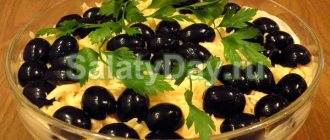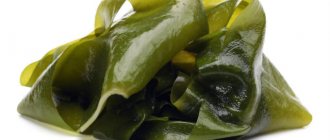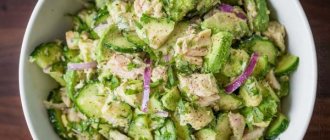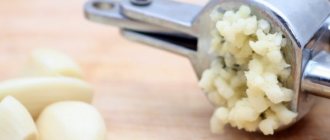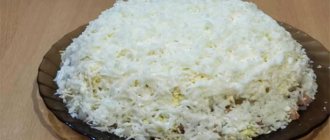Preparing pickled daikon:
1 Prepare the daikon.
Rinse the daikon thoroughly with running water, it is best to even use a special brush. Then remove the skin from the washed root vegetables, peeling it off like carrot or potato skin. Rinse the vegetables one last time, and then wipe them dry with disposable paper towels.
Use a special vegetable grater and grate the daikon. You should end up with very thin, translucent circles.
Place the chopped daikon in a deep plate, add salt to it and stir gently but thoroughly so that every piece is salted.
2 Cook the marinade.
Pour the water into a small saucepan, add sugar, turmeric, bay leaves, cloves and allspice. Place the mixture on the fire and bring to a boil, then pour vinegar into the hot marinade and remove everything from the heat.
3 Prepare the garlic.
While the marinade is boiling, there is time to prepare the garlic cloves. They need to be peeled, cut off the ends, and then cut into thin slices.
4 Marinate the daikon.
Add garlic slices to the daikon salt and stir, then pour in the hot marinade. Mix carefully with a wooden spatula, then place a flat plate on top so that it falls in and press down with your palms. Leave the daikon in the marinade to cool at room temperature for about
1 hour
. Then place everything in the refrigerator and let it sit for a while.
12 hours
, that is, leave it for about overnight. After the radish has been pickled and turned an appetizing golden color, it can be transferred to a sterilized jar and stored in the refrigerator or served.
5 Serve the pickled daikon.
Serve pickled daikon to the table as an appetizer or as a side dish for various hot dishes prepared from fish and seafood, as well as meat or vegetables. And, as I already said, some rolls are prepared using pickled daikon, and now, instead of looking for it in the store, you can make everything at home.
Bon appetit!
Tips for the recipe
– Pickled daikon will keep in the refrigerator for two weeks, so don’t be afraid to make more at once.
– Instead of regular vinegar, it is recommended to use rice vinegar, but it is quite difficult to get, because you don’t always find it in our stores.
– You can cut the daikon into thicker pieces, for example, if you don’t have a special grater, but then you should increase the time it stays in the marinade so that the radish has time to soak.
Recipes
Meat salad with daikon
This delicious vitamin salad is prepared easily and quickly, and comes out with pleasant notes of various flavor combinations: the sweetness of onions, juicy and crispy daikon, aromatic meat. Real jam! Mayonnaise is usually used for dressing, but you can replace it with a lower calorie option (sour cream, mustard, lemon juice). In addition to this salad, fresh tomatoes work well: cut them into small slices and serve with the salad.
You will need:
- 300 grams of daikon;
- 300 grams of boiled meat;
- 3 large red onions.
Preparation:
Cut the onion into half rings, fry over low heat in a frying pan with vegetable oil previously poured onto it.
When frying, bring the onion to a light brown color; it is important not to overcook. Wash the daikon thoroughly, peel it and cut it into strips.
Or chop it on a special grater for Korean carrots. Cut the boiled meat very thinly into strips. Mix all the products, if you like it spicy, you can add some salt. You can choose the dressing at your discretion: any mayonnaise; sour cream; apple cider vinegar with olive or sunflower oil; lemon juice, also with sunflower oil; soy sauce.
Japanese daikon salad
The recipe came to us from the land of the rising sun - Japan. It is suitable for vegetarians and fasting people.
Required:
- daikon – 600 g;
- one large red onion;
- green pea pods or green beans - weighing 100 g;
- sesame oil – 2 tablespoons;
- rice vinegar – 2 tablespoons;
- sesame seeds – 2 tablespoons;
- honey – 2 tablespoons;
- soy sauce - added to taste.
How to cook:
- Carefully peel the daikon, grate it on a coarse grater or cut it into strips using a knife.
- Cut the red onion into half rings.
- Boil the pea pods for 3 minutes. If you don't have peas, you can use green beans.
- Cut the peas crosswise into pieces.
- Mix everything.
- Make the dressing: Whisk together the rice vinegar, honey and sesame oil.
- Mix the salad with the prepared sauce, stir well and put in the refrigerator.
Serve the salad by sprinkling with sesame seeds and adding soy sauce.
It’s best to prepare this salad a little at a time so you can eat it right away. As a last resort, store in the refrigerator for no longer than 24 hours.
Vegetarian salad
Easy to prepare, tasty and healthy salad. Vegetarians should like it. You can eat it for dinner, serve it as a side dish with meat, or as a separate dish for those who like light food.
Products:
- daikon – 300 g;
- carrots – 2 pcs.;
- fresh herbs (parsley, dill);
- walnut – 50 g;
- vegetable oil – 3 tablespoons;
- green apples – 2 pcs.;
- wine vinegar – 1 tablespoon;
- salt, pepper to taste.
How to cook:
- Peel the daikon, apples and carrots, remove the core from the apples, then grate all these products on a coarse grater.
- Dry the nuts in a frying pan without adding oil. Be sure to stir them constantly. After the nuts have cooled, chop them coarsely.
- For dressing, combine vegetable oil and wine vinegar, season it all with salt, pepper and herbs.
- Pour the dressing into the salad, mix thoroughly, sprinkle chopped nuts on top; for beauty, you can put halves of nuts.
Salad with daikon and garlic sauce
The salad is unusual, fresh, and best combined with foods such as chicken and meat.
To prepare you will need:
- daikon – 500 g;
- salad dressing;
- garlic – 2 cloves;
- vinegar 3% - 1 tablespoon;
- sugar - half a teaspoon;
- salt, vegetable oil to taste.
How to cook:
- Peel the daikon and grate into strips.
- Add salt and pepper, leave for half an hour, then drain the juice that has separated.
- Coarsely chop the garlic and fry in a small amount of oil.
- Transfer the garlic and oil from the frying pan into a small bowl, add salt and pepper, season with vinegar, and stir.
- Pour the resulting sauce over the daikon and garnish with parsley.
Spicy salad
The unusually interesting, spicy taste of the salad will go well with meat dishes.
Products:
- daikon – 300-350 g;
- fresh cucumber – 1 pc.;
- carrot – 1 pc.;
- Italian herbs – 1 teaspoon;
- dry garlic – 12-14 teaspoons;
- French mustard (in extreme cases, you can use regular mustard) – 1 teaspoon;
- nut butter – 2-3 tablespoons;
- salt and ground pepper to taste.
How to cook:
How to pickle daikon
Since daikon does not have its own distinct taste and smell, the vegetable is able to well absorb various aromas of herbs and spices.
Therefore, there are different variations of recipes for this dish among different Asian peoples. The most famous recipes for pickled daikon in Korean, since they usually use the maximum variety of spices. The result is a dish that is sometimes impossible to tear yourself away from. These recipes are so popular that many even call daikon Korean radish.
For pickling, you can use any variety of daikon. In Japanese, daikon translates as “big root,” and, indeed, the vegetable slightly resembles a huge carrot, but only white. Usually the vegetable is cut into small slices; their thickness determines how long it will take to marinate.
To speed up the process of making pickled daikon, you can grate the vegetable. It looks especially beautiful if you grate it on a Korean carrot grater.
Attention! The marinating time ranges from two days to a week, depending on the size and thickness of the cut pieces.
In original Korean or Japanese recipes, rice vinegar is mandatory for pickling daikon. But it’s not always easy to get it, so you can use regular table vinegar, or at least wine or balsamic vinegar.
Store properly prepared pickled daikon in the refrigerator for up to two weeks. Therefore, one should not be afraid to prepare it in relatively large volumes.
Japanese cooking recipe with onions and peas
Ingredients of the recipe
- Daikon - 600 gr,
- head of red sweet onion,
- green peas - 100 g,
- sesame oil - 2 tbsp. l,
- rice vinegar - 2 tbsp. l,
- black sesame seeds - 2 tbsp. l,
- honey - 2 tbsp. l,
- soy sauce - to taste.
I found the recipe for this light salad with daikon in Japanese cuisine. I recommend that vegetarians try the salad, and also use it as a meal on fasting days. Peel and grate into thin strips on a coarse grater or cut with a knife. Chop the red onion into half rings.
Cut the pea pods crosswise into small pieces. Peas can be replaced with green beans. Pre-boil peas or beans for no more than 3 minutes in boiling water. Mix the prepared vegetables. Then prepare the salad dressing.
To do this, whisk sesame oil with honey and rice vinegar. Season the salad with this sauce, mix and place in the refrigerator to soak the vegetables for an hour. Serve the salad sprinkled with black sesame seeds and soy sauce. I advise you to eat this salad immediately; if you can’t, then do not store it in the refrigerator for longer than a day.
Nutritional and energy value:
| Ready meals | |||
| kcal 210043.3 kcal | proteins 12001.2 g | fat 1.3 g | carbohydrates 41006.7 g |
| Portions | |||
| kcal 42008.7 kcal | proteins 2400.2 g | fat 0.3 g | carbohydrates 8201.3 g |
| 100 g dish | |||
| kcal 21 kcal | proteins 1.2 g | fat 0 g | carbohydrates 4.1 g |
Procurement quickly and at almost no cost
Since most housewives especially appreciate recipes for quickly preparing winter supplies, let's start with this one. For twisting, you can use regular radish, or the Daikon variety, bred in Japan, which has a blander taste. For one root vegetable for the marinade you will need 1 tablespoon of sugar, 2 times more 9% vinegar (apple vinegar is possible) and a teaspoon of salt. As a seasoning we use turmeric, which is related to ginger; you will only need to take half a spoon (teaspoon). Also, for one radish, several rings of chopped hot bell pepper are added to the twist.
Daikon for quick cooking for the winter
To begin, wash the root vegetables under running water, peel them and cut them into quarters, then chop each of them into thin slices. The resulting slices should be sprinkled with plenty of salt to soften them and get rid of the unpleasant, slightly bitter taste characteristic of radish. We soak the slices with salt for 2 hours, while preparing the marinade: for each root vegetable, pour 200 grams of water into a pan, into which, before it boils, pour sugar and salt in the proportions indicated in the recipe. We also add turmeric, and when the water begins to boil, turn off the marinade and pour vinegar into it.
Root vegetable slices with salt
All that remains is to thoroughly wash off the salt from the radish slices and place them in jars. Next, you need to prepare the seeded pepper slices into rings and season the root vegetable slices with it. For taste, you can add a few sprigs of herbs (dill, parsley) to each jar, as well as a clove of garlic. Next, fill all containers with boiled marinade. For long-term storage, it is advisable to place the container with the preparations in a low, wide saucepan with hot water and boil for about 15 minutes (this process is called pasteurization). Next, close the lids tightly and, after cooling, put them in the refrigerator overnight, after which you can move the twists into the pantry for the winter.
Recipe: Pickled daikon – Pickle daikon for the winter. Cooking secrets.
Good day to you. I noticed that there is very little information on the Internet about how to cook daikon. And when I typed “daikon recipes” I found very few of those same recipes. Meanwhile, in the cuisines of eastern countries such as Korea, Japan, and China, this root vegetable occupies almost the first place. Well, let’s gradually correct this shortcoming and start with a recipe for a dish called “Marinated Daikon.” The dish is very simple to prepare, but after trying it at least once, you can say that you will immediately fall in love with its unforgettable taste.
And to prepare such a not only tasty but also very beautiful snack
You and I will need these ingredients, the exact quantities of which you can read at the top of this recipe.
1. First, as usual, you need to prepare all the ingredients. You need to take fresh daikon, make sure that it is not soft and dried out. Otherwise, the inside becomes like a coarse sponge and is not suitable for any dish. Wash the daikon and peel off the top layer, leaving white, hard pulp.
2. If the daikon is not very large and thick, then cut it into thin circles, and if you got a large specimen, then cut these circles into two or four parts.
3. In order to remove excess moisture from the daikon and the slight bitterness present in this root vegetable, sprinkle the cut daikon circles with salt and allow the liquid to drain. To do this, I placed the daikon on a sieve.
Cooking tips
- Summer varieties of radish are not suitable for using preparations for the winter; winter varieties of radish must be used.
- Radish goes well with many foods - meat, vegetables, seafood, honey.
- You can dress radishes in salads with sour cream, mayonnaise, yogurt, sunflower or olive oils.
- It is better to salt radish dishes at the end of cooking - this way the taste of the radish will be better preserved.
- Grated radish should be squeezed well - it gives a lot of juice.
- Peeled radishes must be used immediately; if left for a long time, they will darken.
- Black radishes will not be bitter if left in cold salt water for a short time.
Korean cabbage with daikon
Cabbage in Korean has its own name - kimchi. Although in recent years the traditional recipe has expanded somewhat and kimchi is prepared not only from cabbage, but also from beet leaves, radishes, cucumbers and radishes.
But this chapter will look at a traditional Korean cabbage kimchi recipe with the addition of daikon radish. This dish not only has an attractive taste, but also perfectly relieves both cold symptoms and the consequences of a hangover.
You will need:
- 2 heads of Chinese cabbage;
- 500 g red bell pepper;
- 500 g daikon;
- head of garlic;
- a bunch of greenery;
- 40 g red hot pepper;
- 15 g ginger;
- 2 liters of water;
- 50 g salt;
- 15 g sugar.
Making Korean kimchi from daikon according to this recipe usually takes 3 days.
- Each head of cabbage is divided into 4 parts. Then each part is cut across the fibers into several pieces with a thickness of at least 3-4 cm.
- In a large saucepan, add salt to the cabbage and, stirring everything with your hands, rub it into pieces of vegetables for several minutes.
- Then fill it with cold water, cover it with a plate and place it under a weight (you can use a large jar of water) for 24 hours.
- After a day, the cabbage slices are transferred to a colander and washed under running water to remove excess salt.
- At the same time prepare the sauce - grind garlic, red hot pepper and ginger through a meat grinder or using a blender, add a few tablespoons of water.
- Daikon and bell pepper are cut into strips, the greens are coarsely chopped
- In a large container, mix all the vegetables, herbs, sugar and sauce mixture.
- The finished salad can be placed in jars, or it can be left in a pan and placed in a cool and dark place.
- Every day you need to check the dish and release any accumulated gases by piercing it with a fork.
- After three days you can do a tasting, but the final taste of pickled cabbage with daikon can take about a week to take shape.
Recipe for “Chimchi from daikon “Kaktugi””:
Wash the daikon, peel it, and cut it into 2-2.5 cm cubes.
Salt, mix, and leave for an hour.
Rinse well and let the water drain.
Add yangnem, ginger, sesame seeds to the daikon and mix everything. It is better to do this with rubber gloves.
We transfer it to a suitable container under pressure and leave it for 1-3 days at room temperature for the katugi to ferment. During the fermentation process, juice will be released, which will almost cover the daikon. After fermentation begins (after 1-3 days), close the container with a lid and put it in the refrigerator.
Subscribe to the Povarenka group on VKontakte and receive ten new recipes every day!
Join our group on Odnoklassniki and receive new recipes every day!
Share the recipe with friends:
| BB embed code: BB code is used on forums |
| HTML embed code: HTML code is used in blogs, such as LiveJournal |
How will it look like?
Good day! A lot has been written about the benefits of pickled Korean cabbage (chimchi): it is low in calories, yet nutritious, rich in vitamins, microelements, lactic acid bacteria, breaks down fats, prevents putrefactive processes in the intestines, prevents cancer, and even saves you from a hangover! But not everyone knows that Koreans ferment not only Chinese cabbage. They make chimchi from almost any vegetable. I would like to present to your attention a recipe for white radish chimchi.
Benefits of pickled daikon
Fresh daikon root has a lot of beneficial properties that practically do not disappear after pickling or fermentation.
Regular consumption of white radish allows you to:
- Cleanse the body as it has a laxative and diuretic effect. The potassium and calcium contained in the vegetable help remove waste and toxins.
- Increase immunity due to the presence of various vitamins, and phytoncides - destroy microbes located in the internal organs.
- Remove stones from the liver and kidneys.
- Improve the nervous system, increase tone.
- Reduce weight, as the vegetable is low-calorie: 100 g of product contains about 18 kcal. Even some supplements do not increase this figure.
- Cleanse the skin: pimples, boils, age spots and freckles disappear.
- Improve the condition of your hair: it becomes shiny and strong.
Chimchi from daikon “Kaktugi”
Good day! A lot has been written about the benefits of pickled Korean cabbage (chimchi): it is low in calories, yet nutritious, rich in vitamins, microelements, lactic acid bacteria, breaks down fats, prevents putrefactive processes in the intestines, prevents cancer, and even saves you from a hangover! But not everyone knows that Koreans ferment not only Chinese cabbage. They make chimchi from almost any vegetable. I would like to present to your attention a recipe for white radish chimchi.
Feature of the root vegetable
Radish has its own characteristics, which determine its consumption. Let's consider the features of the root crop.
Composition of vitamins
In the past, radish was a staple food not only in Russia , but also in foreign countries. And the whole point is in its nutritional characteristics, because it is enriched with a whole complex of vitamins and minerals.
Doctors recommend including it in the diet of those people who have low immunity. The following substances predominate in this vegetable:
- Vitamin A, which maintains human bones in proper condition, strengthens and protects them;
- Vitamin C, which gives strength and energy, and also fights free radicals in the human body;
- Vitamin B, which restores metabolism and has a beneficial effect on the central nervous system;
- Dietary fiber that improves the functioning of the gastrointestinal tract;
- Pantothenic acid, which is the predominant substance for the formation of strong immunity in the human body.
Separately, we can say about phytoncides, which are compounds that cleanse the entire body of microbes, due to which a person gets sick less often and resists serious diseases .
In addition, the vegetable contains potassium, calcium, phosphorus, magnesium, iron and many other useful and familiar substances.
For colds
In winter and autumn, a person can catch a cold and get sick, since at this time immunity most often decreases and cold weather sets in. In general, health is at risk: germs and viruses appear in the atmosphere.
You should know that not only drug treatment helps to cope with the symptoms of a cold; you can also resort to traditional medicine. Unconventional methods of fighting colds put radish in first place.
Don't look at the fact that radish is bitter. The bitter taste of the vegetable can be tolerated in order to recover faster.
Note
Don't let the large amount of pepper scare you. The spiciness and heat can be adjusted by adding paprika. The main thing is to get the pepper pickle. It turns out something like chimchi.
Bridge
Tuska, I trust you unconditionally, so I’ll bookmark the recipe right away. Just tell me, 2 tablespoons of ground pepper? Precisely ground?
Tricia
How delicious! Thanks for the recipe! She galloped off to get a radish.
Chuchundrus
Bridzik
, thank you for your trust Yes, this powder is dry. We have paprika, semi-hot and “spark” (aka chili), I share the subtleties of language and concepts. Well, depending on my mood, I drink, I can sprinkle one piece of light, or maybe some paprika. The main thing is to make such a pepper paste. You can see in the photo
OlgaGera
There is no fence in the tabs. There are no bow feathers. So without him. I'll try to do it today
Chuchundrus
Tricia
, ride carefully, we need you safe and sound
Chuchundrus
Lelka
, feathers are so an option. I have radish leaves.
Tanyulya
Natalya, how delicious. I’ll do it. Now I’ll finish Timkin’s chickpeas, today I also did the same thing in the Korean style with sprouted mung beans, then I’ll bribe some radishes and make them.
Chuchundrus
Tanyulya
, did you germinate the mung beans yourself?
Tanyulya
It turned out so pretty, so juicy!
We don’t sell sprouted products; I sprouted them myself in a thermal server. Just washing it from the greenfingers will make you tired; yesterday I was picking out the peels with tweezers.
Chuchundrus
Wow, you're cool!!!
I walk in circles around this action and convince myself that I don’t like sprouts
Apparently after a science lesson, when I had to germinate beans and I had them: - X began to smell bad instead of sprouting. I decided that I was not able to grow anything.
little orange
Chuchundrus
little orange
Great. just need to be installed
Mikhaska
Again, Chuchik
, you brought a magical yummy so that I would have no peace at night!
How to live! I didn’t want to go to the forum today! No, the devils carried me away... And they brought me! On my own gray head. Tomorrow, of course, I cannot promise that I will create your delicacy. But, in any case, it will be fulfilled. I swear to my mom! Eh, Natusya!
Well, I don’t have any culinary peace with you.
Chuchundrus
I'm sorry, Mikhasya, I'm such a fucking fool, I didn't know what to do, but all sorts of stupid things come out of idleness, so I had to spread the radish spirit, so that I could smoke you out of the bushes
Mikhaska
Hmmm.. Here you are, of course, one hundred percent right! Radish spirit, he will smoke anyone out of the trench!
Chuchundrus
Otherwise I can tell you a lot about chemical weapons
Mikhaska
Gee-s-s! The Ukrainian chemical defense battalion, (according to Zadornov), was standing nearby? Since you have such extensive information?
Olechka.s
Natalya, interesting recipe. Definitely bookmarked! Thank you!
